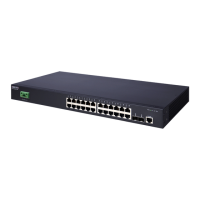C
HAPTER
8
| VLAN Stacking
VLAN Stacking Table
– 62 –
When a double-tagged packet enters another trunk port in an intermediate
or core switch in the service provider’s network, the outer tag is stripped
for packet processing. When the packet exits another trunk port on the
same core switch, the same S-VLAN tag is again added to the packet.
When a packet enters the trunk port on the service provider’s egress
switch, the outer tag is again stripped for packet processing. However, the
S-VLAN tag is not added when it is sent out the tunnel access port on the
edge switch into the customer’s network. The packet is sent as a normal
IEEE 802.1Q-tagged frame, preserving the original VLAN numbers used in
the customer’s network.
VLAN STACKING TABLE
Sets the stacking VLAN membership for selected interfaces to be part of
the Service Provider VLAN (S-VLAN), that is uplink ports for a 802.1Q
Tunnel. This stacking VLAN is used to segregate and preserve customer
VLAN IDs for traffic crossing the service provider network.
The switch supports up to 64 S-VLAN IDs.
PARAMETERS
The following parameters are displayed on the Static VLAN page:
◆ S-VLAN ID - The VLAN identifier of a stacking VLAN. (Range: 1-4094)
◆ Member Ports - Switch ports that are members of the stacking VLAN.
That is, ports that will double tag ingress and egress packets.
WEB INTERFACE
To configure stacking VLAN port members:
1. Click Configuration, VLAN Stacking, S-VLAN Table.
2. Specify the S-VLAN ID number.
3. Mark the ports to be included as stacking VLAN port members for
specified S-VLAN.
4. Click Add.

